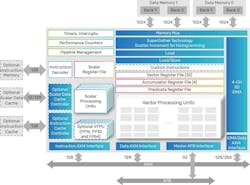New DSPs Plus Radar Accelerator Merge Automotive Vision, Radar, LiDAR, and AI Processing
This article is part of the TechXchanges: Automotive Radar and LiDAR Technology.
Two new Vision digital signal processors (DSPs) plus a radar accelerator were developed by Cadence with an eye toward automotive sensor-fusion applications. The Cadence Tensilica Vision 331 DSP (Fig. 1) and Vision 341 DSP combine vision, radar, LiDAR, and AI processing in a single DSP for sensor-based system designs involving several modes of operation.
Single DSPs can boost performance while providing significant area, power, and cost savings, In fact, Cadence claims the DSPs deliver what the company says is the best energy efficiency in the smallest area. But that’s not all—specialized instructions enable the Vision DSP products to efficiently speed up sensor data processing.
The new Vision 341 and Vision 331 DSPs combine the Tensilica ConnX and Vision instruction-set architectures to provide SoC providers for automotive, drone, robotics and autonomous-vehicle systems with a highly programmable, single-DSP solution for image sensing, radar, LiDAR, and AI workloads. Both DSPs are built on the Xtensa NX controller. Vision 341 is a 1024-bit SIMD, and Vision 331 is a 512-bit SIMD.
Low-Power, Yet Faster, Processing
Specialized instructions also enable the Vision DSP products to efficiently speed up sensor data processing. Various architecture enhancements boost performance while keeping energy consumption low. The Vision DSP products provide flexibility in system implementations at power-consumption levels that are said to significantly reduce the need for hardware accelerators.
In addition, the DSPs incorporate an integrated DMA engine, an interface for instruction memory, an instruction cache, and two AXI interfaces. Also in the mix is a 2048-bit-wide data memory bus. All Vision DSPs are built on the same VLIW SIMD architecture and offer an N-way programming model, allowing for easy software migration from each DSP.
Other features and benefits include:
- Vision 341 offers 2X multiply-accumulate (MAC) capability compared to the Vision 331 while delivering what’s said to be better performance and energy efficiency compared to GPUs or CPUs.
- As the automotive market moves to 4D radar, which provides range, Doppler, azimuth, and elevation information with large data cubes, it becomes challenging to implement the radar processing chain just in programmable DSPs. As a result, the Vision family also includes a Vision 4DR Accelerator (Fig. 2) targeted at a high-resolution imaging 4D radar solution for the automotive market, which brings an area, power, and performance advantage over a DSP-only solution.
- According to Cadence, when paired with the new Cadence Tensilica Vision 4DR Accelerator optimized for 4D imaging radar applications, customers can achieve 3X to 6X greater performance/area advantage compared to a Vision 341 DSP alone, and 5X greater performance compared to a Vision 331 DSP alone.
- The new Vision DSPs deliver up to 2X computer vision performance improvements for computer vision filter and NMS algorithms, again according to Cadence.
Cadence notes that the Vision 4DR Accelerator is able to operate on the large data structures required for today’s automotive solutions. Because of its much higher performance than a DSP-only solution, a combined solution of Vision 331/341 and Vision 4DR also saves considerable power and area.
Language and Library Support
The Vision 341 and Vision 331 DSPs support the Tensilica Instruction Extension (TIE) language, enabling customers to customize the instruction set. The Cadence NeuroWeave software development kit (SDK) provides neural-network support for both DSPs.
In addition, the Vision 341 and Vision 331 DSPs support more than 1,700 OpenCV-based vision library functions, SLAM library, Point Cloud library (PCL), Radar library, Nature DSP library, OpenCL, and the Halide compiler for computer vision, imaging, radar and LiDAR applications.
Both cores are automotive-ready with ASIL B hardware random faults and ASIL D systematic fault certification.
“With the growing prevalence of vision transformers, automotive SoC and systems companies need best-in-class performance for sensor-fusion applications. Increasingly, they are seeking a highly flexible single-DSP solution for computer vision, radar and LiDAR with AI processing,” said David Glasco, VP of R&D for the Silicon Solutions Group at Cadence. “As the leading provider of vision and radar DSP IP, we’re extremely well-positioned to capitalize on this growing need by offering our customers the best of both worlds in a single DSP with optional radar acceleration for emerging 4D radar applications.”
“Automotive architectures continue to evolve with the current focus on software-defined vehicles and the growing prevalence of driver and occupancy monitoring systems,” said Raphaël Da Silva, Technology and Market Analyst at Yole Group. “With the automotive race towards eyes off, a mix of radars, cameras, and LiDARs are necessary to ensure optimal safety performance in all conditions.”
Da Silva added, “There are more than 40 sensors in a vehicle today, and that number will only continue to grow. Having these capabilities in a single, highly programmable DSP with a broad ecosystem is advantageous, particularly as imaging and 4D radar are expected to grow at a >40% CAGR from 2023 to 2028 and >131% for in-cabin use as noted in the Yole ‘Intelligence Radar for Automotive 2023’ report.”
The Vision 331 and Vision 341 DSPs are available now, while the Vision 4DR accelerator will be generally available in the second quarter of 2024.
Read more articles in the TechXchanges: Automotive Radar and LiDAR Technology.


